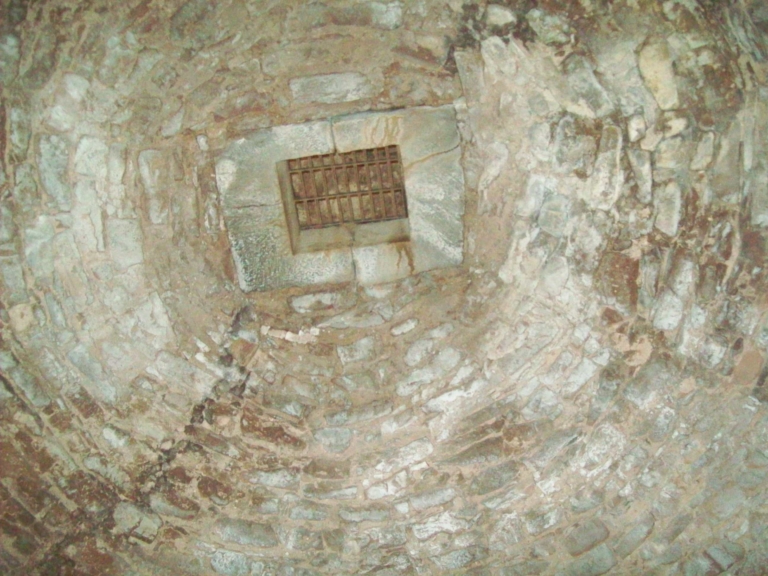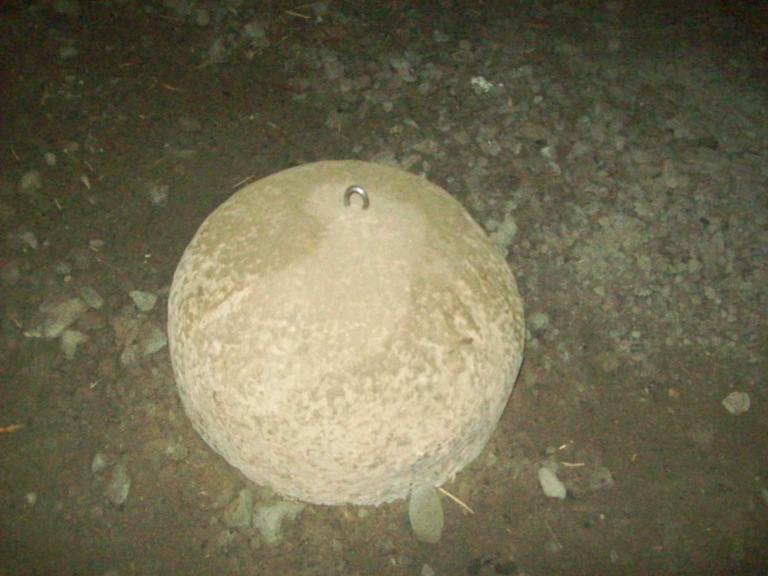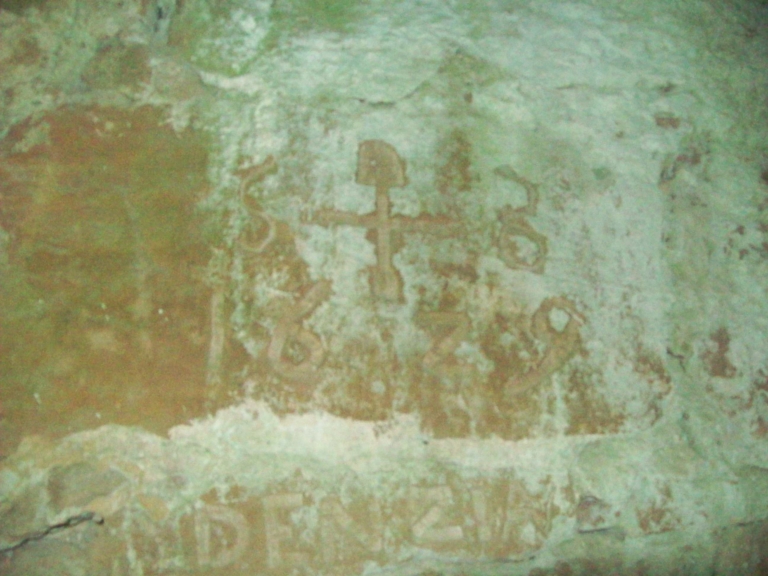On a Friday in April of 2012, my boss asked me if I was interested in taking a trip to Frankfurt, Germany in three days’ time. I quickly said yes – for work, of course, but what was more important to me was the chance for a trip to Europe on the company’s dime. I asked if I could spend a few extra days there after the official part of the trip was over, and lucky for me, he said yes. Genealogy trip, here I come!
After I got off the phone, I called my mom, who had done a fair bit of family history with her cousin. I was particularly interested in the Faust line of her family, which they had traced back to Johann Faust coming from Langenselbold, Germany in the early 1730s. Fortunately, Langenselbold happens to be about a half hour east of Frankfurt, so I made plans to go there after my work trip.

A Fascinating Ancestor…
I began to research Johann Faust and literally struck genealogy gold over the next few hours on sites such as Ancestry, Rootsweb, etc. But one ancestor stood out to me in particular – a certain Margaret Faust, who had a very sad fate.
According to the story on one of the genealogy sites, Margaret Faust was accused of being a witch in 1597. The information I found on her from others’ Faust family trees stated that she couldn’t see out of one eye, was 52 years old, and hung herself in the Witch’s Tower at Büdingen Castle (also not far from Langenselbold). Looks like I would be making another detour to find out more!
Making the Plans…
My first bit of travel planning included finding out that the castle was still open and provided tours. A reply to my first email indicated that the tour would cost 5 Euro, but that they needed 5 people to make the tour. I told them that if nobody else showed up I would pay the entire 25 Euro myself!
On the flight over, I gathered my printouts and created a family tree of Johann Faust. Surprisingly, I was able to identify almost all of Johann’s ancestry back to the mid-1500s. But of course, Margaret’s record stood out. What was the rest of her story?

When I arrived at the castle in Büdingen, I wandered around a bit and spoke with some of the other visitors (looks like I didn’t have to pay the 25 Euro myself!). When I met the tour guide, Christa, she said “Oh, you’re the American they said was coming.” I told her about my discovery of Margaret Faust, and was surprised to hear that Christa recognized her name. She then told me that the Witches’ Tower was actually on the town wall, not at this castle, but that I should stick around after the tour and she could tell me more.
The Witch Trials…
Once the tour was over, she invited me to a coffee shop so she could tell me about the witch trials. Apparently, in the late 16th century, the residents of the area were under the impression that God was punishing them. They believed that the famine, wars, etc. they were enduring were a result of people among them associating with the devil. The townspeople labeled these people as “witches” and felt it was their duty to eradicate them from their communities to regain God’s favor. Unfortunately – and perhaps not surprisingly – there were also circumstances where these accusations were used to get rid of someone for convenience reasons or to get the money off a widow.
When an individual was accused of being a witch, he or she would be brought forward for questioning. When they were asked the questions, the initial response was denial. But as the torturing began and continued, eventually most victims would admit guilt in order to make the torturing stop. Often they were coerced into giving up a name of another “witch” in their association. But Margaret’s story ended a little differently, which is why Christa had recognized her name.
She asked to see the details I had about Margaret. Christa was pretty sure that there was a book published that included Margaret’s story. Wonderful! I gave her my email address so that she could send me any information that she could find. Then she offered to give me a private tour of the tower. As a tour guide for the city, she had a key for it, so we headed over there to see the spot where my ancestor apparently had her last moments.
A Private Tour…


The tower looked like a small stone silo. Originally, it had no doors or windows, only an opening in the roof where the victims were lowered in a basket by rope. Of course, there was a door now for tour access. I now stood, with the lights off, in the same place where my ancestor had supposedly died over 400 years ago. Both creepy and fascinating.



Continuing My Research of Margaret…
After I expressed my extreme thanks, I walked around a bit and headed back to Frankfurt. By the time I got back, I found that Christa had already sent me the author and name of the book she’d mentioned, entitled “Hexenprozesse in der Grafschaft Büdingen” by Walter Niess. A quick search online revealed a single used copy of the book on German Amazon – I ordered it right away and asked if it could be shipped to my German host Andreas, who kindly agreed to ship it to me after I’d returned home.
Shortly thereafter, Andreas received the book from Amazon, translated all the parts about Margaret Faust, emailed me the translation, and shipped me the book. Since then, I have translated and reviewed more of the book and came to the realization that the specific details about Margaret’s story in many family trees, including mine, were incorrect! Though almost all of the accused in the area were taken to Büdingen and held in the tower there, Margaret and three other women were actually held in the jail in nearby Birstein, under the chancellory at the castle. These women were all from Rinderburgen and appear to be the only ones taken to Birstein for interrogation and torture. That part of the castle was rebuilt in the 1700’s, so that jail is no longer there. While it was true that Margaret hung herself, the location was different. Goes to show you what you can find when you dig a little deeper into the stories you read!
Although I was not in the actual place where my ancestor had died, it was still a moving experience to be in the type of place my ancestor spent her last moments. It was an amazing trip, and I am grateful to my tour guide Christa for taking the extra time to show me the Witches’ Tower and to my host Andreas for having me and for helping me with the book. It’s exciting what information is out there to discover!
About the Author:

I grew up in and now reside in Wisconsin. I am a mechanical engineer by profession. As a child I was interested in the local cemeteries where my ancestors were buried, often copying the inscriptions. They could be found in numerous cemeteries in southwest Wisconsin. My mom had an interest in family history as well and would share stories that she heard from her parents and grandparents. She worked with her cousin to research their common family history and had traced the Faust line back to Johann Faust, arriving in America from Langenselbold, Germany in the 1730’\s.
After I gathered so much info on the Faust line, I needed a better family tree program to manage it all better. I began using the program from MyHeritage.com and was overwhelmed with the links that it provided to others with common ancestors, giving me the ability to substantially add to my family history. Soon I was up many late nights following leads that would take my family tree much farther in the past than I could have imagined. My tree now has over 1,300 names including direct connections to William the Conqueror, Charlemagne, and the Grandfather of William Wallace in Scotland.

10 Responses
Hi Scott,
I am so glad I found your post here, and I hope you see this and respond, even though I am years after the original posting. I am a fellow Faust descendant and have always been fascinated by Margaret’s story, and that of her potential relations Anna and Katherine. I am going back to rework a story I wrote as a kid about her, and hopefully turn it into a novel. I have released my research is greatly lacking, even though I, too, went to Germany (2010) and stood below the Hexenturm in Budingen. I’m a little jealous that you got such an awesome tour. I didn’t even know that was possible at the time. Thank you for sharing your photographs of the inside. I would love to hear more about your research on Margaret and the other Faust witches, and would be willing to pay you for your translation of Walter Neiss’s book. There is one copy available online that I’m debating buying (it is no longer available on Amazon, even the German Amazon), but of course I do not speak German so I’ll have a lot of work to translate. That book is surprisingly difficult to locate, and appears to be the only account of the Budingen trials. I am happy to share my own research if you have any questions. Hopefully we can help each other. Regardless, thank you for sharing this bit of history, as even this has been very helpful.
Sincerely, JA Stein
This is actually a new post! I just passed on your message to Scott. How fun that you share your ancestor!
I replied via email.
Hello Scott Biba,
Thank you for sharing your fascinating family witch story… I also have a witch ancestor.
In 1625 the first wife (Agatha Ketterer) of my 9th great grandfather Martin Kern was burned as a witch in Triberg, (Schwarzwald) Germany…13 years later a BRAVE woman married him…her name was …
Margareta SCHUNHART (my 9th great grandmother)….and that is why I here.
I am searching for clarity on this story, but my inquiry emails to Triberg officials & historic societies etc, received no help. ( Maybe they are embarrassed, and do not want to promote this history).
Do you know if there is a data base or collection of histories for German witch trials etc.?
We are descendants of FALLER Family of the Black Forest. Check Faller Genealogy pages for BF info. http://www.frontiernet.net/~wderoche/faller.html#greet
Agatha Ketterer Martin Kern
“Witches”. Letter from EAF Sr. to Richard Faller April 25, 1943:
“A story of the Faller House: Agatha Ketterer, farmer on the Lehmansgrund, was accused of witchcraft; she was thus tortured, in order to bring her to confession, and subsequently burned. (This occurred around 1625.) She is supposed to have bewitched the milk of other farmers’ cows so that they would give blue (skimpy) milk, while her own cows would give such excellent butter. She is supposed to have made this butter on the “Ankenbühl” farm. The name Ankenbühl remains the same even today; but she (Ketterer) was not burned at this place; she was taken to the city of Triberg. A commemoration or service for this “witch” was established by her husband. It is still held to this present day. This husband’s name was given to be Martin Kern…. he remarried.
“The farmer on the Falligrund (on the upper Fallengrund) was also accused of performing witchcraft. Under torture he did not prove himself as obstinate as Ketterer, but was beheaded. As this farmer was supposedly on the way to the scaffold, he supposedly said to his friends: “If I go where God is, I will ask of him that I am allowed to bring my child with me to him.” The five-year-old little boy became ill really immediately and after five weeks was dead…
Danke
Linda Holda
My wife’s 12th gr. grandmother, Anna Murschel (maiden name unknown) has a similar story. She was born about 1533 and lived in Balingen, Wüttemberg. She was imprisoned in 1598, and eventually released due to the influence of one of her sons, a Lutheran pastor. She died of the plague in 1611. The following is the description of her story that my wife has assembled.
The following is an account of the charges/defense which were brought against her in the witchcraft trial:
“In her defense it was said that she was a hard-working woman who did all the work running her household because her drunkard of a husband was too busy with his Bürgermeister duties. The witnesses testified to her piousness – regular prayers, reading the Bible, regular attendance at church, no swearing etc, etc.
However, she did walk with a limp, and appeared to poke her nose into the business of others in the community, which created enemies. Also, being a widow, and physically worn from years of child rearing, she was a prime target for persecution.
The Prosecution made the following claims:
– The watchman of the town gate said that he never saw her go out early in the morning. Yet in midmorning she came back in. Of course she must have flown over the wall.
– A neighbour led his foal past her house and it died the same day. She must have cast a spell.
– She offered an apple to the Vogt’s wife who went into premature labour that day.
– When she blew off the dust from a mug, some of it hit a woman who later developed “holes in her breast” (late-stage cancer, I assume) and died.
– A young man was sitting with a group of friends (drinking heavily I assume) in a room. Suddenly he felt a chill down his back and she was standing behind him. Nobody saw her enter, so she must have come in through the wall. Later that night the man found that his “manhood” was gone. Definitely an evil spell.
– A man had been hauling a heavy load between Balingen and somewhere else without any problems but when he gave her a lift, the horse dropped dead. Guess whose fault?
– A friend of Anna’s, also accused of witchcraft, testified under torture that, on some nights, she and Anna and others had been cavorting with the devil and his companions. She even named Anna’s devil partner in sin.
– Anna and friends had been seen out in the fields shortly before a devastating storm destroyed the crops.
– She had a birth mark (mark of the devil) on her body.
Her life was saved by a statement from the law faculty of the Univ. Of Tuebingen where the verdict was that there was not enough proof of witchcraft. She was lucky in having educated sons with connections to the university. Her friends were not so lucky.”
——————
Note: Accused of practicing witchcraft and imprisoned in Balingen
from 1598 to 1600. Found innocent of the charges in 1600. I have a
copy of the letter written by her lawyer asking for return of money
spent on “room and board” while in prison. The letter also speaks of
the terrible conditions and torture she had to endure while
imprisoned (see below). Lisbeth Zahawi indicates that Anna could probably read,
as she was found reading religious material when visited in prison,
but it is unclear whether she could have composed and written this
particular document herself. The signature on the document is not
hers.
See: Hexenprozessakten, Hauptstaatarchiv Stuttgart, A 209, Buschel 144.
——————-
Description of the torture of Anna Murschel – 18 August 1598 – 5 April 1600 (596 days) . She was tried and imprisoned 18 August 1598. Torture started 26 September 1598. She was released 5 April 1600.
Anna was subjected to “Strappado,” or reverse hanging, the arms behind the back, the body hanging freely. In such cases the arms were usually dislocated. Weights were added to her hands and feet, but the executioner did not get a confession of guilt from Anna.
The court then brought in a special executioner from Horb, who was known to have had success in getting many women to confess. This executioner believed that the devil was in Anna’s hair, so he hung a sack of consecrated candles around her neck and sprinkled them with holy water. He also gave her bitter potions to break the devil’s spell. He saw marks (birth marks) on Anna’s left arm and right leg which he interpreted as the stigma of the devil.
On the second day, he repeatedly called out to the devil to come out of Anna. When this did not succeed, he had Anna stretched on the ladder (rack), which can also dislocate arms and legs. Afterwards, Anna could no longer move her left arm, or use it, as it hung limply at her side.
Anna remained firm despite the torture and punishment and continued to assert her innocence. She wept bitterly when her pastor visited her. She hoped that the way in which she had handled her torture demonstrated her innocence.
The torture continued until her release on 5 April 1600.
Note: While in prison, Anna Murschel was required to pay 100 Gulden for “room and board.” The protest letter written on her behalf contains details of her torture, which are described in the section above.
————————
See multimedia for Balingen church epitaph. It was painted by Simon Schweitzer, a local sculptor and painter, in 1595, a year after Caspar Murschel died. The painting, “Jesus in the Temple” is not the original. The figures at the bottom are the Murschel family. Caspar and his sons are to the left. His 2 wives and their daughters are to the right. Anna, his second wife, is to the far right in the painting. We do not know the maiden names of the wives.
Scott, this is a great story. I am trying to determine if the “Last Witch of Langenburg” is a relative of mine. Her name was Ann Schmieg, which is my mother’s maiden name, and the family comes from Schwäbisch Hall, which is close to where Anna lived, and died in 1672. I haven’t had luck yet but I keep trying.
Hello, Scott. What a fascinating story! Do you know anything about the carving on the inside of the tower?
This is what it says in the source book, Hexenprozesse in der Grafshaft Budingen.
“Strange signs and inscriptions with years can still be found in the sandstones of the tower’s interior today. A fallen light is carved next to the year 1562. One would certainly not be mistaken in thinking that this depiction was intended to point to the violent extinguishment of a life. This motif is generally interpreted as a warning reference to the Büdingen witch trials.”
Hi Scott!
I recognized your name in the email from Germanology and knew I had to read the post and I am so glad I did. What an incredible experience and story! I would love to be able to go to Germany to visit the towns my family are from.
Jennifer Kron (Your 3rd cousin through the Richter/Pettera line)
My brother and I wrote a historical fiction book on this story. In it I take the known details from Margaret’s story and fill in the blanks to give it some life.
“Accused: The Witch Trial of Margarethe Faust”
It is available on Amazon, in case anyone is interested.
https://a.co/d/iiukkui